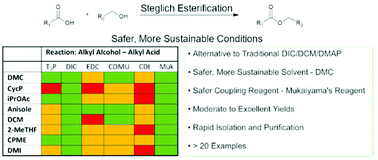A solvent-reagent selection guide for Steglich-type esterification of carboxylic acids†
Abstract
The Steglich esterification is a widely employed method for the formation of esters under mild conditions. A number of issues regarding the sustainability of this transformation have been identified, chiefly the use of hazardous carbodiimide coupling reagents in conjunction with solvents with considerable issues such as dichloromethane (DCM) and N,N-dimethylformamide (DMF). To overcome these issues, we have developed a solvent-reagent selection guide for the formation of esters via Steglich-type reactions with the aim of providing safer, more sustainable conditions. Optimum reaction conditions have been identified after high-throughput screening of solvent-reagent combinations, namely the use of Mukaiyama's reagent (Muk) in conjunction with solvent dimethyl carbonate (DMC). The new reaction conditions were also exemplified through the synthesis of a small selection of building-block like molecules and includes the formation of t-butyl esters.

- This article is part of the themed collections: Sustainable Laboratories and 2021 Green Chemistry Hot Articles


 Please wait while we load your content...
Please wait while we load your content...